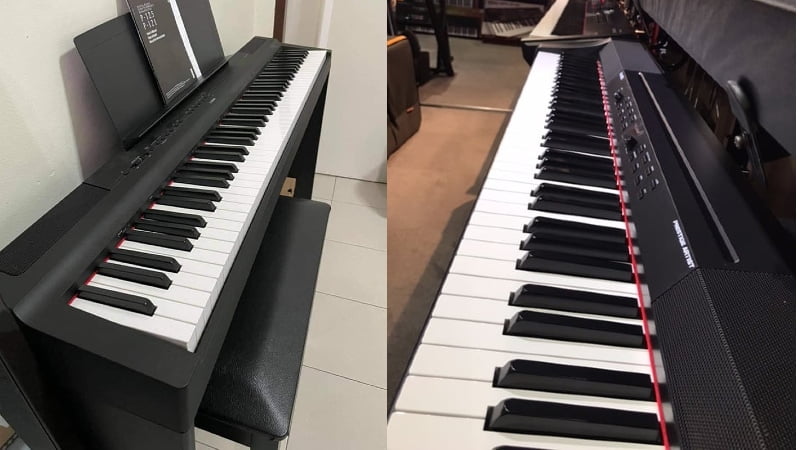If you’re comparing the Alesis Prestige Artist to the Yamaha P125, one of the most common questions that arise is, “Is the Yamaha P125 worth the higher price tag?”.
The answer?
Yes, the Yamaha P125 comes with an incredibly great set of features that are fit for both beginners and even professional pianists. Since it’s more expensive, you can expect a fair amount of premium features such as different playing modes, great feel, and the signature bright and clear Yamaha piano tones.
While I found the Yamaha P125 to be a much better option over the Alesis Prestige Artist, that doesn’t mean the Alesis model didn’t have great features. The Alesis Prestige Artist is an affordable, entry-level digital piano that contains features that are usually seen on more expensive options such as a varied sound library and MIDI connectivity, making it a great beginner’s piano.
Alesis Prestige Artist vs Yamaha P125: Comparison Chart




Last update on 2025-04-16 / Affiliate links / Images from Amazon Product Advertising API
Alesis Prestige Artist vs Yamaha P125: Differences
To determine the best option between these two pianos, I compared the features head-to-head. And since the Yamaha P125 is the premium option, it ended up winning by a fair amount. The final score after comparing the features was 3-1. While the Alesis Prestige Artist put up a fair fight against the Yamaha P125, it simply couldn’t compete against the superior tone and feel of the Yamaha model.
Tone
The winner: Yamaha P125
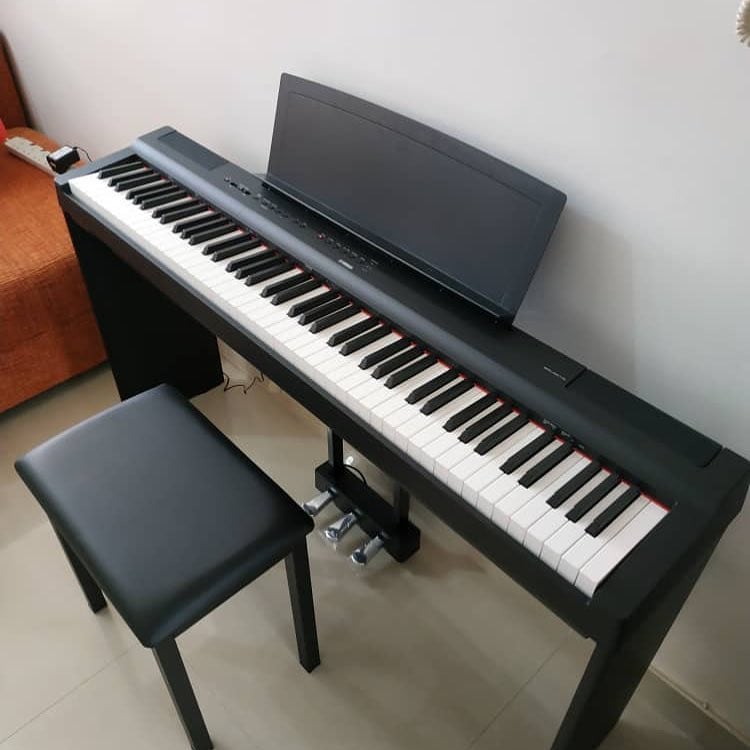
One of the main reasons the Yamaha P125 is more expensive is its tone generation. The Yamaha P125 features the PureCF Sound Engine, which is known for recreating the signature tones of some of the most famous Yamaha acoustic pianos out there. And while the Alesis Prestige Artist has a wider sound library, the quality of voices on the Yamaha P125 is so much better.
+ Tone Generation
The Alesis Prestige Artist uses multi-sampled voices. In its price range, it’s hard to find a digital piano that can compare. Every time you press a key down on the Alesis Prestige Artist, you trigger multiple samples of the same note. This provides a much richer and stereo tone that mimics the feel and sound of a real acoustic piano. And by the ear test alone, I found that the piano tones on the Alesis Prestige Artist far exceeds expectations.
With that said, the Yamaha P125 uses the PureCF Sound Engine. This is a signature Yamaha feature that is known for creating incredible piano tones. The way this works is by sampling real Yamaha CFIII Concert Grand Pianos with top of the line equipment and a digital filter. The result is a seemingly perfect recreation of the classic Yamaha piano tone, which greatly outdoes the Alesis Prestige Artist.
While the trained ear can still tell that the Yamaha P125 is a digital piano, it is far more realistic than the tones on the Alesis Prestige Artist. This doesn’t just go for the piano tones, either, as the Yamaha P125 outdoes the Alesis model’s tones in just about every category. And for that reason, the Yamaha P125 is the clear winner in a tone comparison.
+ Sound Library
At first glance, it might seem like the Alesis Prestige Artist has a better sound library than the Yamaha P125. And to be honest, there is some truth to this. The Alesis model comes with 30 different voices you can choose from, while the P125 only comes with 24. This isn’t a large difference, but it is significant enough for some pianists.
However, since the difference isn’t too great, both of these pianos share a lot of similar voices. On either option, you can access different acoustic and electric piano, strings, synth, and bass tones. And since the tone generator of the Yamaha P125 is more sophisticated, the voices are much more high-quality. So, while the Alesis Prestige Artist has a better quantity of voices, the quality of the voices is much more important, which is where the Yamaha P125 easily wins.
Feel
The winner: Yamaha P125
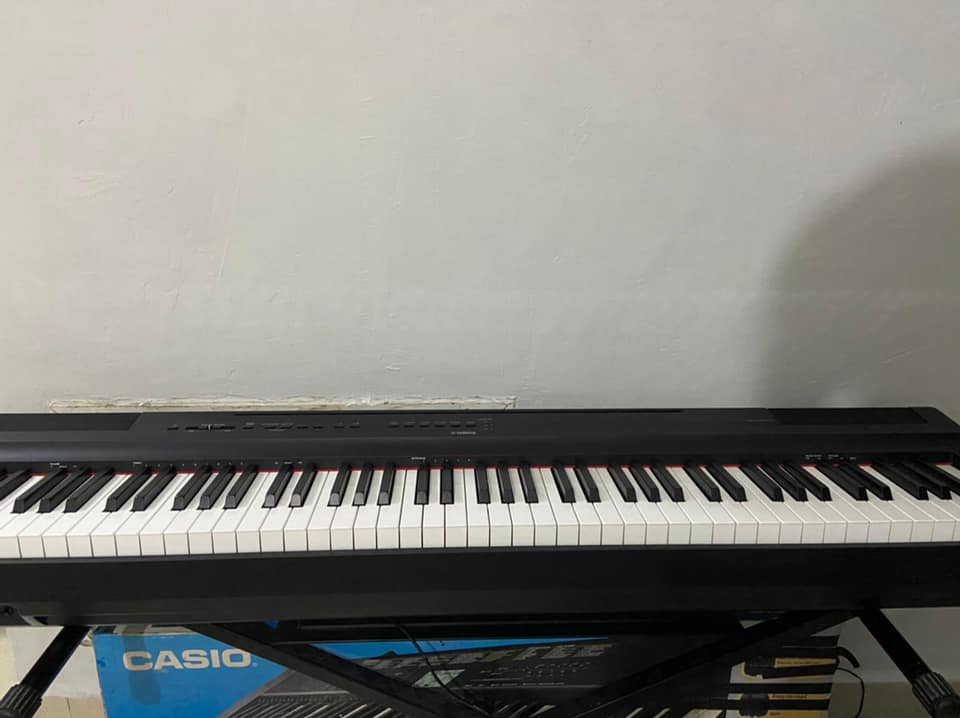
Feel and playability go hand in hand on the Yamaha P125. With Yamaha’s signature GHS installed and textured keys to mimic the feel of a real, wooden acoustic piano, this model easily took the cake. With that said, the Alesis Prestige Artist also comes with scaled hammer action, but the glossy key texture was a slight letdown, which is why it lost in this regard.
+ Hammer Action
The Yamaha Graded Hammer System (GHS) is specifically designed to mimic the weight of an acoustic piano. It does this by applying heavier action on the left side of the piano that gets progressively lighter as you move on to the higher keys. And after playing the piano myself, I found that it feels really close to a real acoustic piano. The action is just the right weight and properly distributed, adding a lot of realism to the playing experience.
The Alesis Prestige Artist has a similar hammer action system. However, when playing the Alesis Prestige Artist, I noticed that the action was on the heavier side. On top of that, the keys can be a bit noisy. With that said, keep in mind that the Alesis model is a beginner’s piano, so these details aren’t too noticeable. But as you get better at the instrument and play more acoustic pianos, you’ll start to feel the extra weight, which can get annoying after a while.
+ Key Texture
The Alesis Prestige Artist has glossy keys. They are made out of plastic, and while that’s just normal for pianos in this price range, it’s still a let down. If you’ve played a lot of acoustic pianos, you’ll instantly feel the difference in key texture with the Alesis Prestige Artist. The glossy finish is shiny and eye-catching for sure, but it does a poor job of providing an authentic acoustic piano feel.
On the flip side, the Yamaha P125’s keys are fully coated. That means they are still made of plastic, but they contain a coating meant to mimic the matte-finish and the texture of real wooden keys. And while it still feels a bit plastic-like, I had to admit the Yamaha P125 does a great job. The P125 arguably has some of the most realistic feel in its price range because of the combination of the GHS and the matte finish on the white keys.
Piano Features
The winner: Tie
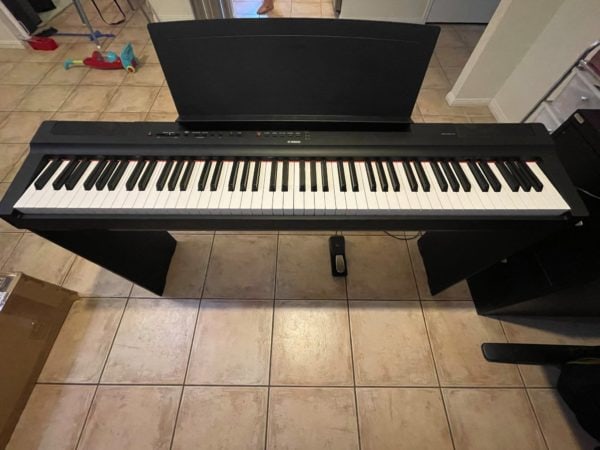
This is the only area where I found the Alesis Prestige Artist to put up enough of a fight to tie the Yamaha P125. Surprisingly, the Alesis Prestige Artist has the same playing modes and better connectivity options than the Yamaha P125. However, because of the wide array of effects available on the Yamaha P125, I had to declare it a tie.
+ Polyphony
At first glance, it might seem like the Alesis Prestige Artist has better polyphony than the Yamaha P125. Since it has a maximum polyphony of 256, many people assume that it’s better than the P125. However, keep in mind that the Prestige Artist uses multi-sampled voices. So, since you play multiple samples per note, the polyphony in practice is closer to 128, which is the same as the P125.
With either of these pianos, you can play dense chords with the sustain pedal and embellish them with little touches here and there. You don’t have to worry about the piano not being able to handle all the notes, since they are both equipped to handle even the most challenging and dense piano pieces.
+ Effects
In terms of effects, the Yamaha P125 takes the cake. The Yamaha P125 has IAC, Damer, Resonance, Ambience, and Reverb effects, you have a whole lot of control over your tone. The P125 even has a sound boost which can help if you’re playing with a band and need a few extra decibels for a certain part or section. Granted, beginners won’t exactly use all of these effects, but they are very useful the more advanced you get. And as you start to develop your own signature tone, all of these effects will make it much easier to tweak the sound of the piano.
The Alesis Prestige Artist only comes with reverb. With that said, this is arguably the most important effect as it adds a lot of depth and body to the piano’s tone. If you’re a beginner, reverb is probably the only additional effect you are going to need and offers a whole lot of room for experimentation down the line.
+ Connectivity
In terms of connectivity, the Alesis Prestige Artist takes the cake. This is because the Alesis model supports MIDI connectivity via USB. Sadly, this feature isn’t available on the Yamaha P125. With MIDI connectivity, you can use the piano to control virtual instruments and even hook it up to piano lesson apps on your computer!
+ Playing Modes
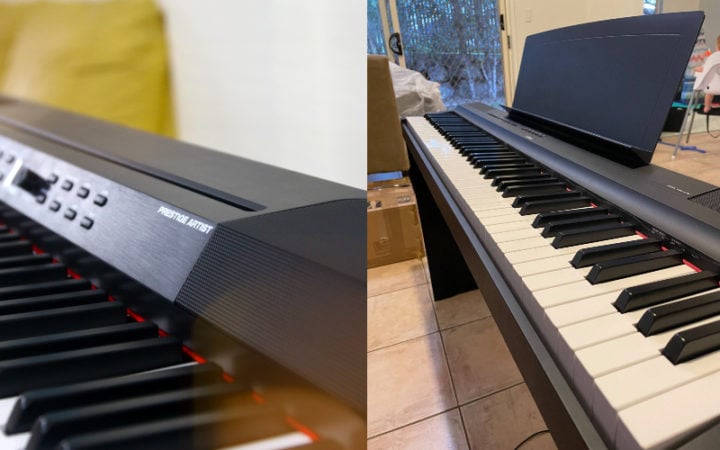
Both of these pianos come with the same playing modes. These are split, dual, and duo mode. Split mode allows you to assign one voice to each side of the piano, dual mode blends the sound of two voices, and duo mode divides the keyboard into two twin pianos. All of these playing modes are very useful and can be very important for beginner and novice pianists.
One advantage offered by the Yamaha P125, however, is recording. You can record your playing on the Yamaha P125 and listen back to it to judge your own playing. While the sound quality won’t be good enough for recording a song, it’s definitely good enough to help you judge your own piano playing.
Alesis Prestige Artist vs Yamaha P125: The Similarities
These are two very different pianos. So, they don’t share too many similarities. They are both 88-key pianos with some sort of progressive hammer action, which is one of their most significant similarities. Additionally, they both have three different types of touch sensitivity, which is a great help for pianists, especially when playing particularly hard pieces.
The Yamaha P125 is designed for beginners to novice pianists. The Alesis Prestige Artist is solely geared towards beginners. With that, you can’t expect a lot of similarities between the two. However, when writing this comparison, I found that it was actually their difference that made these pianos so interesting!
Quick Rundown of the Yamaha P125
- A fully weighted digital piano with 88 full sized piano style keys
- GHS weighted action is heavier in the low keys and lighter in the high keys, just like an acoustic piano
- The pure CF sound engine faithfully reproduces the tone of the acclaimed Yamaha 9 feet CFIIIS Concert grand piano; Tempo range: 5 to 280
- Split mode lets you play a different voice with each hand; Tuning: 414.8 440.0 to 446.8 hertz
- USB to host connectivity with MIDI and audio transfer means you only need 1 cable to connect to your music making software
Last update on 2025-04-16 / Affiliate links / Images from Amazon Product Advertising API
Quick Rundown of the Alesis Prestige Artist
- It’s Time to Upgrade your Electric Piano – 88 key piano keyboard with graded hammer action and adjustable touch response for a natural piano feel - for beginner, intermediate and advanced players
- Packed with Premium Sounds - 30 multi-sampled voices including Grand Piano, Electric Piano, Organ, Synthesizers & more; simultaneous Split & Layer modes; built-in arpeggiator; 5 adjustable Reverb FX
- Authentic Playing Experience - 256 max polyphony provides a superb 88 key piano playing experience; 50W micro-array speaker system sounds loud, clear and realistic in any setting
- Stage Piano Essentials – OLED screen for intuitive control; Stereo 1/4” outputs; 1/4” and 1/8” (3.5mm) headphone outputs; USB-MIDI output for use with educational software or virtual
- The Complete Full Size Keyboard Piano Experience - Piano style sustain pedal, music rest, and power adapter included; Lesson & Record Modes to develop your electric keyboard piano skills
Last update on 2025-04-15 / Affiliate links / Images from Amazon Product Advertising API
Product Videos
Related Articles to Yamaha P125
- Yamaha P150 vs P125: The Battle of the P-Series Models
- Yamaha P125 vs CLP 625: Can a Beginner’s Digital Piano Match the Clavinova?
- Yamaha P125 vs Roland FP 60: Which is the Better Investment?
- Yamaha P-121 vs P-125: Finding the Best Portable Yamaha Piano
- Yamaha P125 vs Korg LP 380: Which Piano Is Better for Your Needs?
- Yamaha P125 vs P85: Can the Outdated Digital Piano Beat the Newer One?
- Yamaha P125 vs DGX 670: Which Piano Comes Out on Top?
- Yamaha P125 vs Korg SP 280: Which is the Better Beginner’s Digital Piano?
- Yamaha P-255 vs P-125: Finding the Better Option for Beginners
- Yamaha P125 vs YDP S34 Comparison: Does the Portable P125 Hold Up Against a Console Digital Piano?
- Yamaha P125 Vs YDP 164: Should You Get A Console Or Digital Piano?
- Yamaha YDP 103 Vs P125: Should You Get a Portable or Console Digital Piano?
- Yamaha P125 Vs Kawai ES110 Comparison: Which Is The Best Portable Digital Piano
- Yamaha P125 vs Casio PX S1000: Which Digital Piano Is Worth Your Money?
- Casio PX-870 Vs Yamaha P-125: Should You Get A Portable Or Console Digital Piano?
- Alesis Recital Vs Yamaha P125: Which Is The Right Pick For You?
- Yamaha P45 VS P115: Which P-Series Newbie Gives You More Value for Money?
- Alesis Recital Pro vs Yamaha P125 Comparison: Which Is The Best Portable Digital Piano?
- Yamaha P125 vs Casio PX-770 Review: Why the Yamaha P125 Beats Out the Casio Console Digital Piano
- Yamaha P125 vs DGX 660 Comparison: Can the P125 Hold Its Own Against the DGX 660?
- Yamaha P125 vs Roland FP-30X Review: Why the Roland FP-30X Comes Out On Top
- Yamaha P125 vs P515 Review: Why the Yamaha P515 Is the Better Investment
- Yamaha P115 vs P125 Review: Can the P125 Beat Out Its Predecessor?
- Yamaha P125 vs Roland FP30: A Close Battle Between Two Great Digital Pianos
- Yamaha P45 vs P125: Why the Yamaha P125 Is the Better Pick for Pianists
- Yamaha P71 vs P125: Why the Yamaha P125 Is the Better Investment
Related Articles to Alesis Prestige Artist
- Alesis Prestige Artist vs Korg B2: The Better $500 Digital Piano
- Alesis Prestige Artist vs Recital Pro: Which Is the Best Alesis Piano for Beginners?
- Alesis Prestige Artist vs Yamaha P45: Can Alesis Hold Its Own Against the Popular Yamaha Model?
- Alesis Prestige Artist vs Roland FP-10: Which Is the Best Beginner’s Digital Piano?
- Alesis Prestige vs Prestige Artist: Can the Alesis Prestige Hold Its Own Against the Upgraded Prestige Artist?
References:
- P-125: https://usa.yamaha.com/products/musical_instruments/pianos/p_series/p-125/specs.html#product-tabs
- Alesis Prestige Artist 88-key Digital Piano w/ Graded Hammer Action Keys: https://www.sweetwater.com/store/detail/PrestigeArt–alesis-prestige-artist-88-key-digital-piano-with-graded-hammer-action-keys
Lulacruza is an electronic folk duo operating at the junction of the hypermodern and the ancient. Our music weaves together hypnotic female singing, South American folk instruments and electronic processing, while channeling pulsating waves from the source of creation.
Lalucruza is also a community where you can connect with other music lovers to collaborate, exchange ideas and share knowledge. A platform for who wants to learns the basics of playing piano, guitar, drum masters’ technique, etc.. is the premise of our website.
